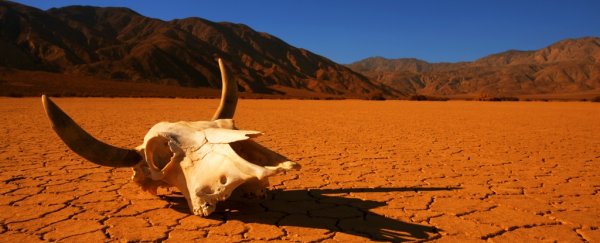Mass extinctions don't just come unannounced. In fact, we're staring down the barrel of the latest one, according to new research.
Scientists have determined that, contrary to previous assumptions, there were early warning signs for the biggest mass extinction event in history. We now know what those warning signs are, and there are alarming parallels observable today.
Such events are not uncommon in the historic record, and the fact that Earth is crawling with life today, indicates that they don't completely obliterate life on the planet.
But mass extinctions do alter the course of how life develops. Without the extinction of some dinosaurs, for example, the rise of the mammals - including humans - may never have occurred.
The largest mass extinction that we know of was the Permian-Triassic event. It occurred 252 million years ago, marking the end of the Permian period and the beginning of the Triassic. It killed a shocking 96 percent of all marine life, and up to 70 percent of all life on land.
It's thought to have been caused by massive volcanic activity in Siberia, which majorly altered the atmosphere all around the world, and led to the collapse of many ecosystems - partially, perhaps, because of the effect volcanic activity had on the ozone layer, thinning it and disrupting plant life cycles.
For the last 20 years or so, it was accepted that this event happened suddenly and without warning. One day, everything was fine. Next day, boom.
But according to a research team from Friedrich-Alexander University Erlangen-Nürnberg and the Museum für Naturkunde in Germany, that's not how it went down. By examining previously unresearched fossils in Iran, they have now found warning signs as early as 700,000 years before the event occurred.
They found that several species of ammonoids - marine molluscs also known as ammonites - were killed off around that time, and the species that survived grew increasingly smaller and less complex.
There were other signs, too - and they are shockingly familiar.
"There is much evidence of severe global warming, ocean acidification, and a lack of oxygen," said lead author Wolfgang Kießling of the FAU.
"What separates us from the events of the past is the extent of these phenomena. For example, today's increase in temperature is significantly lower than 250 million years ago."
There is other work that suggests a build up to the Permian-Triassic event. A 2015 paper found, in an analysis of the geochemical record, that there was progressive environmental deterioration leading up to the event itself. Another 2015 paper found high levels of magma activity before, during and after the event.
Other researchers have found that, in the last million years of the Permian period, brachiopod sizes were decreasing on land; in the sea, protozoa called radiolarians were also in decline.
There's evidence that marine animals may be shrinking today. Last year, researchers revealed that the Atlantic menhaden has reduced in size by 15 percent in the last 65 years, likely as a direct result of climate change.
The team's research joins a growing body of evidence and chorus of scientists warning that we're on the verge of Earth's sixth mass extinction event.
"The increased rate of extinction in all habitats we are currently observing is attributable to the direct influence of humans, such as destruction of habitat, over-fishing and pollution," Kießling said.
"However, the dwarfing of animal species in the oceans in particular can be quite clearly attributed to climate change. We should take these signs very seriously."
The team's research has been published in the journal Geology.
